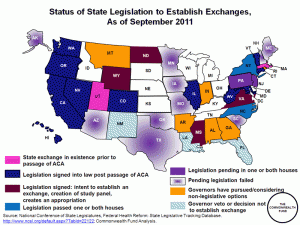
One of the challenges in building the new state exchanges under the Affordable Healthcare Act for state insurance commissioners and stakeholders will be to guard against unplanned consequences. The possibility that the exchanges could end up with a lopsided share of high need enrollees, while the young and healthy are able to find less costly coverage outside these exchanges is a significant threat to overall success.
The following are the major obstacles state regulators and other stakeholders must overcome to ensure the success of insurance exchanges:
(1) Adverse selection: Coverage options available within the exchanges must be attractive to and affordable for individuals and small employers in order for them to be economically worthwhile. Regulation of insurers — both on and off the exchanges —will be the deciding factor for every state in determining whether their exchange becomes a viable entity. If an exchange is left with too many potentially expensive enrollees, then two parallel, unrelated markets will spring up.
(2) Eligibility: Most states will need to develop and implement an eligibility system for not only their exchanges but for their Medicaid program as well. It would be rather easy to simply determine eligibility for exchange enrollees but Medicaid users cannot be ignored. This translates into coordination with older, legacy systems that are not all that flexible, or put another way a lot of discipline and planning to encompass Medicaid eligibility.
(3) Legacy Medicaid systems: Technology developed for the exchanges will have to allow members to easily switch between Medicaid and subsidized coverage as eligibility status changes. Also, it will need to transmit and receive data from HHS regarding subsidies and citizenship status as well as collect and remit premiums. The IT for the exchanges will need to incorporate the ability to determine eligibility and administer health benefits beyond Medicaid. Safeguards will be necessary to keep enrollees in a medical home and not have them moving from plan to plan because of income eligibility changes.
(4) Federal deadlines: While the exchanges must be operational by January 1, 2014, set up and testing must be completed before that. The federal timeline is rather aggressive, and it will be a challenge for every state. Even by compressing preliminary stages, there is little time for pilot implementations to test exchange rules and functionality. The need to meet timelines established by the Affordable Care Act has created a “monumental task” for states. Further, political unanimity must be established among all stakeholders, but sometimes people work better under tight deadlines.
(5) Momentum: Some states’ legislatures meet only every other year, so it’s crucial that legislation is enacted this session to illustrate to the federal government that they are serious about moving forward. Maintaining forward momentum is necessary to ensure eligibility for the next round of federal grants that will be used to build out the exchange.
(6) State mandates: The basic benefit package needs to be consistent across states. Once the mandatory package is clearly defined, then decisions about additional state-mandated benefits can be possible. It will be important to keep in mind that everything added will increase the cost of the premiums, and that anything not included in the federal requirements will have to be paid for by the state or the consumers.
(7) Business model: Before the framework can be developed, states must first recognize the needs among individuals and small employers and then decide how the exchange can meet those needs. Planning funds are being utilized to develop and test business models as well as corroborated planning between Medicaid and states. Further a public stakeholder process will assess ideas.
(8) Brokers: Enrollees and small employers will need assistance traversing the exchanges. In the end it will be the brokers who will serve a vital role in the development of the exchanges, and they will need to be compenated for their services so they will be willing to help consumers and employers.”
(10) Care delivery: The exchanges must do more than just enroll members in coverage. States cannot just deliver insurance but rather offer an adequate provider work force who can address people’s health needs. States should not forget the public health and prevention factor of healthcare reform, and hence focus on an integrated approach in order to make the delivery of care more efficient.
